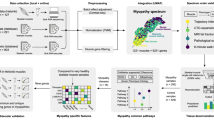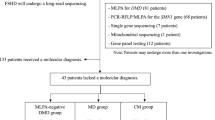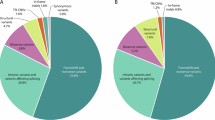Abstract
We report a family affected with childhood onset distal muscle weakness with a heterozygous chromosome 9q34 deletion encompassing the SPTAN1 gene. The deletion was detected through exome-sequencing based copy number variant (CNV) detection, segregates in four patients and is non-penetrant in two other relatives. Electromyography, muscle MRI and muscle biopsy revealed a myopathic disease phenotype. Cellular consequences of the deletion were investigated using qPCR and western blotting on patient-derived fibroblasts, which revealed a reduction of RNA but not protein levels. Immunocytochemistry was performed on muscle tissue which did not reveal reduction of α-II-spectrin. SPTAN1 loss-of-function variants have previously been reported to cause distal hereditary motor neuropathy and recently distal myopathy. Here, we confirm the role of SPTAN1 haploinsufficiency as a cause of distal myopathy. We propose an age-dependent lack of α-II-spectrin and suggest CNV detection in repurposed exome sequencing as an important diagnostic tool.
This is a preview of subscription content, access via your institution
Access options
Subscribe to this journal
Receive 12 print issues and online access
$259.00 per year
only $21.58 per issue
Buy this article
- Purchase on SpringerLink
- Instant access to full article PDF
Prices may be subject to local taxes which are calculated during checkout



Similar content being viewed by others
Data availability
The genetic data is available after registration through the RD-Connect GPAP (https://platform.rd-connect.eu/). All other data is available from the authors upon reasonable request.
References
Hartley T, Lemire G, Kernohan KD, Howley HE, Adams DR, Boycott KM. New diagnostic approaches for undiagnosed rare genetic diseases. Annu Rev Genom Hum Genet. 2020;21:351–72.
Wise AL, Manolio TA, Mensah GA, Peterson JF, Roden DM, Tamburro C, et al. Genomic medicine for undiagnosed diseases. Lancet. 2019;394:533–40.
Zurek B, Ellwanger K, Vissers LELM, Schüle R, Synofzik M, Töpf A, et al. Solve-RD: systematic pan-European data sharing and collaborative analysis to solve rare diseases. Eur J Hum Genet. 2021;29:1325–31.
Demidov G, Yaldiz B, Garcia-Pelaez J, de Boer E, Schuermans N, Van de Vondel L, et al. Comprehensive reanalysis for CNVs in ES data from unsolved rare disease cases results in new diagnoses. NPJ Genom Med. 2024;9:49.
Beijer D, Deconinck T, de Bleecker JL, Dotti MT, Malandrini A, Andoni Urtizberea J, et al. Nonsense mutations in alpha-II spectrin in three families with juvenile onset hereditary motor neuropathy. Brain. 2019;142:2605–16.
Van De Vondel L, De Winter J, Beijer D, Coarelli G, Wayand M, Palvadeau R, et al. De novo and dominantly inherited SPTAN1 mutations cause spastic paraplegia and cerebellar ataxia. Mov Disord. 2022;37:1175–86.
Syrbe S, Harms FL, Parrini E, Montomoli M, Mütze U, Helbig KL, et al. Delineating SPTAN1 associated phenotypes: from isolated epilepsy to encephalopathy with progressive brain atrophy. Brain. 2017;140:2322–36.
De Winter J, Van de Vondel L, Ermanoska B, Monticelli A, Isapof A, Cohen E, et al. Heterozygous loss-of-function variants in SPTAN1 cause an early childhood onset distal myopathy. Genet Med. 2025;27:101399.
Stankewich MC, Cianci CD, Stabach PR, Ji L, Nath A, Morrow JS. Cell organization, growth, and neural and cardiac development require αII-spectrin. J Cell Sci. 2011;124:3956–66.
Huang CYM, Zhang C, Ho TSY, Oses-Prieto J, Burlingame AL, Lalonde J, et al. αII spectrin forms a periodic cytoskeleton at the axon initial segment and is required for nervous system function. J Neurosci. 2017;37:11311–22.
Lorenzo DN, Edwards RJ, Slavutsky AL. Spectrins: molecular organizers and targets of neurological disorders. Nat Rev Neuroscie. 2023;24:195–212.
O’Brien TD, Campbell NE, Potter AB, Letaw JH, Kulkarni A, Richards CS. Artificial intelligence (AI)-assisted exome reanalysis greatly aids in the identification of new positive cases and reduces analysis time in a clinical diagnostic laboratory. Genet Med. 2022;24:192–200.
Matalonga L, Hernández-Ferrer C, Piscia D, Cohen E, Cuesta I, Danis D, et al. Solving patients with rare diseases through programmatic reanalysis of genome-phenome data. Eur J Hum Genet. 2021;29:1337–47.
Laurie S, Steyaert W, de Boer E, Polavarapu K, Schuermans N, Sommer AK, et al. Genomic reanalysis of a pan-European rare-disease resource yields new diagnoses. Nat Med. 2025;31:478–89.
Vandeweyer G, Reyniers E, Wuyts W, Rooms L, Kooy RF. CNV-WebStore: et al. Analysis, Storage and Interpretation. BMC Bioinformatics. 2011;12:4.
Riggs ER, Andersen EF, Cherry AM, Kantarci S, Kearney H, Patel A, et al. Technical standards for the interpretation and reporting of constitutional copy-number variants: a joint consensus recommendation of the American College of Medical Genetics and Genomics (ACMG) and the Clinical Genome Resource (ClinGen). Genet Med. 2020;22:245–57.
Structural Variants in gnomAD v4. gnomAD browser. https://gnomad.broadinstitute.org/news/2023-11-v4-structural-variants/ (2024).
Sun KY, Bai X, Chen S, Bao S, Zhang C, Kapoor M, et al. A deep catalogue of protein-coding variation in 983,578 individuals. Nature. 2024;631:583–92.
Smith C, Parboosingh JS, Boycott KM, Bönnemann CG, Mah JK, Lamont RE, et al. Expansion of the GLE1-associated arthrogryposis multiplex congenita clinical spectrum. Clin Genet. 2017;91:426–30.
Kaneb HM, Folkmann AW, Belzil VV, Jao LE, Leblond CS, Girard SL, et al. Deleterious mutations in the essential mRNA metabolism factor, hGle1, in amyotrophic lateral sclerosis. Hum Mol Genet. 2015;24:1363–73.
Zhou D, Ursitti JA, Bloch RJ. Developmental expression of spectrins in rat skeletal muscle. Mol Biol Cell. 1998;9:47–61.
Vybiral T, Winkelmann JC, Roberts R, Joe EH, Casey DL, Williams JK, et al. Human cardiac and skeletal muscle spectrins: differential expression and localization. Cell Motil Cytoskeleton. 1992;21:293–304.
Kikkawa Y, Matsunuma M, Kan R, Yamada Y, Hamada K, Nomizu M, et al. Laminin α5_CD239_Spectrin is a candidate association that compensates the linkage between the basement membrane and cytoskeleton in skeletal muscle fibers. Matrix Biol Plus. 2022;15:100118.
Duan R, Kim JH, Shilagardi K, Schiffhauer ES, Lee DM, Son S, et al. Spectrin is a mechanoresponsive protein shaping fusogenic synapse architecture during myoblast fusion. Nat Cell Biol. 2018;20:688–98.
Sert O, Ding X, Zhang C, Mi R, Hoke A, Rasband MN. Postsynaptic β1 spectrin maintains Na+ channels at the neuromuscular junction. J Physiol. 2024:602:1127–45.
Yavarna T, Al-Dewik N, Al-Mureikhi M, Ali R, Al-Mesaifri F, Mahmoud L, et al. High diagnostic yield of clinical exome sequencing in Middle Eastern patients with Mendelian disorders. Hum Genet. 2015;134:967–80.
Retterer K, Juusola J, Cho MT, Vitazka P, Millan F, Gibellini F, et al. Clinical application of whole-exome sequencing across clinical indications. Genet Med. 2016;18:696–704.
Gartner V, Markello TC, Macnamara E, De Biase A, Thurm A, Joseph L, et al. Novel variants in SPTAN1 without epilepsy: an expansion of the phenotype. Am J Med Genet A. 2018;176:2768–76.
Morsy H, Benkirane M, Cali E, Rocca C, Zhelcheska K, Cipriani V, et al. Expanding SPTAN1 monoallelic variant associated disorders: From epileptic encephalopathy to pure spastic paraplegia and ataxia. Genet Med. 2023;25:76–89.
Acknowledgements
Several authors are members of the European Reference Network for Rare Neuromuscular Diseases (ERN EURO-NMD, project N°870177). We thank the participating patients and relatives for their cooperation in this study.
Funding
JB and VT are part of the μNEURO Research Centre of Excellence of the University of Antwerp. This work was supported by the EU Horizon 2020 program (Solve-RD under grant agreement N°779257). JB is supported by a Senior Clinical Researcher Mandate of the Research Fund – Flanders (FWO) under grant agreement N°1805021N. LVdV is supported by a predoctoral fellowship of the FWO under grant agreement N°11F0921N and the Peripheral Nerve Society Laura Feltri Basic Research Fellowship. JDW is supported by the Goldwasser-Emsens fellowship.
Author information
Authors and Affiliations
Contributions
LVdV performed and designed experiments and wrote the manuscript. JDW collected clinical data and aided in manuscript writing. AM and NC performed experiments. TD and KJ performed diagnostic validation of the variant. GM, AAJ, WDR collected clinical data. GD, SL conducted experiments within Solve-RD. WDR, BE and VT designed experiments, aided in manuscript writing. JB designed experiments, reviewed data and performed manuscript writing.
Corresponding author
Ethics declarations
Competing interests
The authors declare no competing interests.
Ethical approval
All experiments performed in this study were approved by the University of Antwerp ethical committee. Informed consent was obtained from all patients that were evaluated.
Additional information
Publisher’s note Springer Nature remains neutral with regard to jurisdictional claims in published maps and institutional affiliations.
Supplementary information
Rights and permissions
Springer Nature or its licensor (e.g. a society or other partner) holds exclusive rights to this article under a publishing agreement with the author(s) or other rightsholder(s); author self-archiving of the accepted manuscript version of this article is solely governed by the terms of such publishing agreement and applicable law.
About this article
Cite this article
Van de Vondel, L., De Winter, J., Monticelli, A. et al. A heterozygous 9q34 deletion encompassing SPTAN1 as a cause of distal myopathy. Eur J Hum Genet (2025). https://doi.org/10.1038/s41431-025-01938-2
Received:
Revised:
Accepted:
Published:
DOI: https://doi.org/10.1038/s41431-025-01938-2



